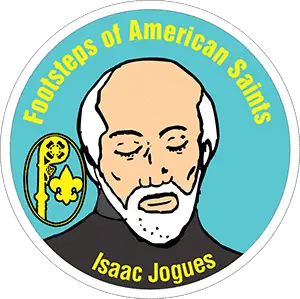The North American Martyrs were eight Jesuit missionaries who went to Canada in the 17th century. They aimed to spread Christianity among the Huron people.
St. René Goupil was a Jesuit lay brother and the first of the group to be martyred, in 1642. Originally trained as a surgeon, he was unable to take vows due to poor hearing. Nonetheless, he volunteered to go to New France and served as a medical aide. He was captured and killed by Mohawk warriors shortly after arriving.
St. Isaac Jogues was a priest captured by Mohawk warriors in 1642. He was tortured and held in captivity for a year before escaping. Despite this, he returned to continue his mission and was killed in 1646. He's known for his strong will and enduring faith.
St. Jean de Lalande was a Jesuit lay brother who accompanied Jogues on his final journey. He was killed shortly after Jogues in 1646. Little is known about his early life, but his sacrifice alongside Jogues highlights his dedication to the mission.
St. Antoine Daniel was a priest who worked to compile a Huron dictionary and catechism. He was killed during an Iroquois attack on a Huron village in 1648. He stood firm, encouraging Christian Hurons to keep their faith even as they were attacked.
St. Jean de Brébeuf was a key figure in the Jesuit mission to the Hurons. He learned the Huron language and wrote extensive records of his experiences. He was captured and tortured by the Iroquois in 1649 and showed remarkable courage before his death.
St. Noël Chabanel was a teacher in France before joining the mission in New France. He found it hard to adapt to the new land and culture but remained committed. He disappeared in 1649, believed to be killed while retreating from Iroquois forces.
St. Charles Garnier was a devoted priest who chose to stay with his Huron converts during an Iroquois attack, despite the risks. He was killed in 1649 while tending to a wounded man. His dedication to the mission and his flock was unwavering.
St. Gabriel Lalemant was the last of the eight to be martyred, also in 1649. He had spent only a short time in the missions when he was captured and killed by the Iroquois. Despite his short service, he was committed to his missionary work and faith.
Legacy and Lessons of the North American Martyrs
The North American Martyrs' collective legacy is one of courage, dedication, and unwavering faith. Their willingness to face hardship and danger has inspired many to take up missionary work or to be steadfast in their beliefs. Their stories are often cited in Catholic literature and teachings as examples of ultimate sacrifice for faith.
Cultural Contributions
Several of these missionaries, like St. Jean de Brébeuf and St. Antoine Daniel, took steps to understand and respect the Huron culture. They compiled dictionaries and wrote catechisms in the Huron language, laying groundwork for cultural exchange. Their efforts, though not always welcomed, showed an intent to engage respectfully with indigenous cultures.
Educational Influence
The Jesuits are well-known for their focus on education, and these martyrs were no exception. Their teachings, writings, and efforts to create dictionaries and catechisms have been studied by scholars and serve as historical documents, helping us understand both the Jesuit and Huron cultures of the time.
Patron Saint of ...
The North American Martyrs are the patron saints of Canada.
Daily Mass Readings for the Memorial of the North American Martyrs
In addition to the suggested readings below, the readings may also be taken from the weekday readings, the Common of Martyrs, or the Common of Holy Men and Women.
- First Reading - 2 Corinthians 4:7-15: We face various challenges, but we're not defeated. Our struggles reveal Jesus' life in us. We're united in faith, and our tribulations serve a greater purpose: to glorify God.
- Responsorial Psalm - Psalm 126: We were filled with joy when God restored us. Our suffering led to happiness, recognized even by other nations. Despite initial sorrow, we find joy in the end.
- Gospel - Matthew 28:16-20: Jesus met the Eleven in Galilee, where he endowed them with the mission to make disciples globally. He assured them of his perpetual presence until the end of time.
St. Isaac Jogues Activity – Footsteps of the American Saints
The Footsteps of the American Saints program encourages all Catholic youth to get to know holy men and women who lived in America or who had a strong influence on American life. One of the saints included in this series is St. Isaac Jogues, who is one of the North American Martyrs.

Learn About St. Isaac Jogues
The first step in the activity is to learn about St. Isaac Jogues, one of the North American Martyrs, and answering a few questions about him. Here are the basics of his story.
Sent as a Missionary
St. Isaac Jogues was born in Orleans, France on January 10, 1607. He was ordained a Jesuit priest in 1636 and was sent as a missionary to Quebec. He and some fellow priests were captured by the Mohawk Iroquois. He was tortured and lived as a slave among the Iroquois until some Dutch traders ransomed him.
A Living Martyr
While among the Iroquois he taught them about Christianity. Upon his return to Europe, he was greeted with joy and revered for being a “living martyr.” Everyone thought he had already died. His hand had been so mutilated by the earlier torture that he had to be given a dispensation by Pope Urban VIII to say Mass since the Church law at the time said that only the thumb and forefinger could touch the host.
His Return
After a time, he returned to New France (Canada), but the Mohawks were suspicious of him and his fellow missionaries. He was killed by a tomahawk blow on June 29, 1646. Seven other North American martyrs were also killed. St. Isaac Jogues feast day is celebrated on October 19.
Other Requirements
The second part of the program involves some activities to understand why St. Isaac Jogues and the North American Martyrs are important to us. These include the following choices:
- A discussion of his life
- Drawing a picture of the things he did
- Creating a collage with the other martyrs who died with St. Isaac Jogues
- Creating a cross and hanging it in a room
Get the Patch
Upon completion of the activity, a patch may be ordered. This program is sponsored by the National Catholic Committee on Scouting, but it is open to all youth and adults whether they are involved in Scouting or not. Read the full requirements for the patch.

Leave a Reply